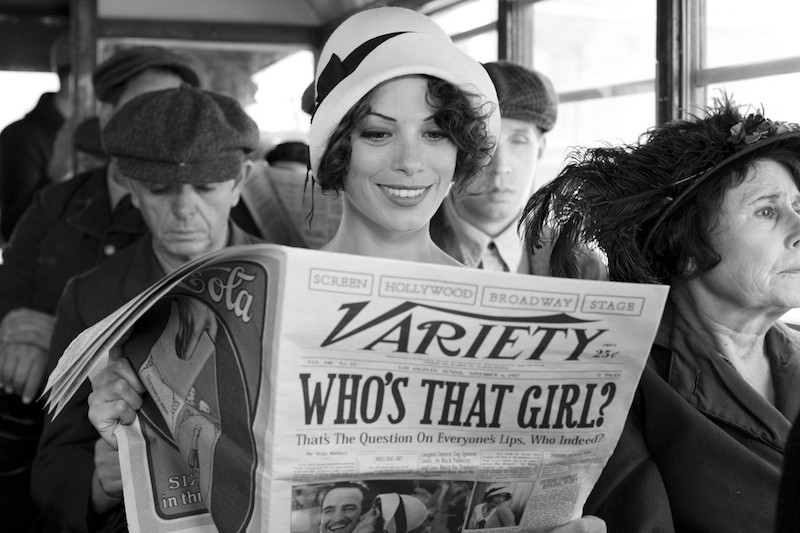I can see why so many folks in the American movie biz have both admiration and affection for The Artist as well as why it’s received almost universal acclaim from critics. While it does drag a bit in the middle, I found the film a delight on the whole — and I love the fact that the audience at my show clapped at the end.

Applause when a movie concludes, based on the unscientific sampling that is my own theatergoing experience, is much rarer today than when I was a kid. I’m not sure if that’s because people are more used to watching movies at home (in smaller parties and/or alone) or because there are fewer films that rouse an audience to applause than there used to be; either way, it’s one of the fun, communal aspects of seeing a flick on the big screen in a packed house. The Artist is definitely one to savor in such a setting, surrounded by other film buffs in near-darkness with the smell of popcorn in the air.
I won’t spoil anything here. You likely already know the gist of The Artist and, if you haven’t seen it yet, know whether you want to.

Written and directed by Michel Hazanavicius, The Artist is a mostly silent film set at
the end of Hollywood’s silent-film era and the dawn of talkies — set, indeed, within the movie industry itself, where we find marquee idol George Valentin marginalized by new technology, changing tastes, and his own hubris. Like fellow recent releases My Week with Marilyn, Hugo, and to a lesser extent The Muppets (as I wrote last month), it’s a movie about movies.
French actor Jean Dujardin plays Valentin and looks in the role very much like his obvious inspiration Douglas Fairbanks, whom he “quoted” (as I wrote the next day) in his winning speech at Sunday’s Golden Globes. Bérénice Bejo, who eerily resembles the young Rickie Lee Jones, is his sassy match as rising star Peppy Miller; she has a meet-cute encounter with Valentin early in the film and pops back into his life in various ways throughout. Dujardin, leading man of Hazanavicius’ popular OSS 117 spy films, and Bejo, Hazanavicius’ wife, possess the requisite chemistry — but you’re forgiven if the pairings that most tickle you are Dujardin/Valentin’s with the dog and Bejo/Miller’s with a jacket and coat rack.

The lack of familiarity with Dujardin and Bejo among audiences outside of France works in the film’s favor, while by contrast some recognizable faces from movies and television in supporting turns can at first be jarring. Despite rhapsodizing in my Hugo review about the magic that allows us to dissociate (in any distracting way, at least) actors from previous roles when they’re properly cast in a good film, I found that the appearance of such American actors as John Goodman, Penelope Ann Miller, James Cromwell, Malcolm McDowell, and Joel Murray took me out of the action momentarily, before ultimately adding to the unreality of The Artist in a positive sense. It’s as if the actors were less dissolving into their roles, with the audience complicit in its own deception, then being transformed into avatars of themselves in odd roles in a dream sequence within a film that consists of nothing but the dream sequence. No, I’m not entirely sure what I mean by that either; it’s just the best that I can describe the phenomenon right now. What’s important as always is that the emotion is genuine even as the artifice remains enchanting — in this case, all the more gloriously so by how artificial it is.
Of course The Artist is, like those it homages, a silent film only as regards the absence of spoken dialogue. It does occasionally employ absolute silence, to superb effect, including once early on in a fashion that reminds us that we are watching an ode to the very sort of thing we are watching with the benefit of hindsight and with the silence being a deliberate artistic choice rather than standard operating procedure. But The Artist also uses intertitles for dialogue and has a great score of borrowed and original music for which composer Ludovic Bource himself won a Globe. The rest of the crew operates in similarly rarefied air, from editors Hazanavicius and Anne-Sophie Bion to production designer Laurence Bennett to cinematographer Guillaume Schiffman.

I expect that if The Artist trumps Hugo when the last envelope is opened on Oscar night, Martin Scorsese will be as quick to his feet as he was at the Golden Globes, which is a testament to him as a gentleman and a lover of film. Hugo still edges out The Artist, however, as not only my favorite release of last year but, measured by any conceivable metric in my mind, the best. It’s almost criminal that these two very moving, very beautiful, very different movies that each look back at the creation of silent films in their own way are pitted against one another during this awards season. What are the odds that the most beguiling movies of 2011 would be a pair of films taking place 80 years ago — one an American production set in France about a French auteur (if that’s not a redundancy); the other a film set in Hollywood, made by one?
Images © 2011 TWC / Lantern Entertainment.
Related: Projections • Ghosts in the Machine • Paris Review • 42
Favorites: #11 • Nothing Special • Pre-Oscars Post • Crystalized

No comments:
Post a Comment